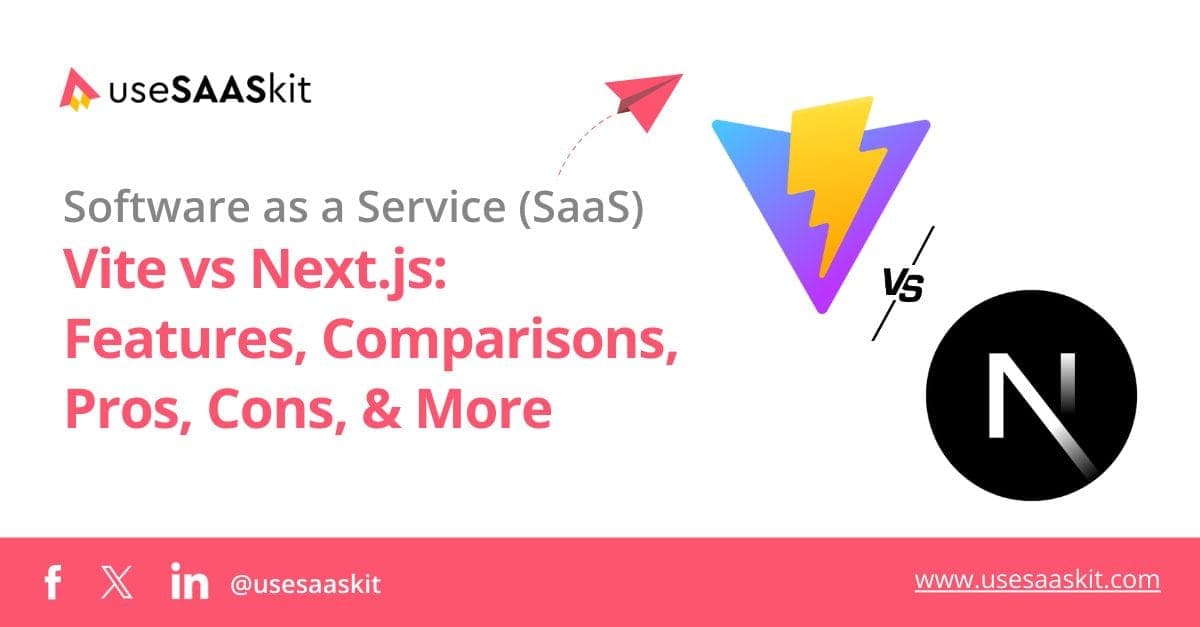Thursday, 20 Feb 2025
6 min read
Vite vs Next.js: Features, Comparisons, Pros, Cons, & More

Choosing the proper tool for developing web applications efficiently is important and crucial. Between Vite and Next.js, two of the most popularly used technologies for building fast applications, they address different needs yet are often pitted against one another for the sake of performance and speed. Vite, in particular, is a build tool that provides high-speed building with native ES modules and instantaneous Hot Module Replacement (HMR). It is lightweight, simple, and it works perfectly with several frameworks like Vue, React, and Svelte. Meanwhile, Next.js is a powerful React framework which is advanced in doing work such as SSR and static site generation, which is best for SEO-friendly and high-performance applications.
In this blog post, we explore the differences in features, the best use case for each one, advantages and performance benchmarks in comparison between Vite and Next.js. Whichever you choose-between a speediest frontend tool for development and a full-fledged React framework-this guide helps you decide best which one of these fits well into your project.
Table of Contents
- What is Vite?
- What is Next.js?
- Key Differences Between Vite and Next.js
- Features Comparison: Vite vs. Next.js
- Performance Benchmarks
- Pros & Cons of Vite
- Pros & Cons of Next.js
- When to Use Vite vs. When to Use Next.js
- Conclusion
- FAQs
What is Vite?
Vite is an ES module frontend build tool built by Evan You, the Vue.js creator, designed to make your development process as fast as possible by natively using Hot Module Replacement. Vite works like a smart bundler by only processing the code when required, which not only reduces the time taken but also makes the whole process highly efficient. So, it would be a very good choice for modern frontend projects.
In contrast to Webpack, Vite eliminates slow re-bundling, and hence, ensures immediate updates while in development. Optimized build processes and on-demand code compilation make it a good fit for developing high-performance applications. You can work with Vue, React, or other frameworks, but Vite helps to streamline your development so that you can concentrate more on clean and efficient code writing.
Key Features of Vite:
- Lightning-Fast HMR: UI updates in near real-time, without full page reloads.
- Native ES Module Support: Leverages modern browser capabilities to speed up development.
- Optimized production builds: This uses Rollup under the hood to bundle and optimize assets for production.
- Framework-Agnostic: Supports Vue, React, Svelte, and more.
- Plugin System: It uses the Rollup-based plugin architecture to extend functionality.
What is Next.js?
It is a powerful developer-friendly React-based framework for development. It enables the development of server-rendered and statically generated applications. Further, automatic routing, API handling, and image optimisation are incorporated within Next.js, which makes development easier and more efficient. These features promise improvements in website performance, user experience, and SEO. Hence, most new web applications prefer using Next.js.
With Next.js, you can create fast, scalable, and SEO-friendly websites without any additional configuration. It supports both static and dynamic content, allowing for flexibility in a wide range of projects, from blogs to enterprise applications. It simplifies complex tasks and improves performance for anyone, from beginner to experienced developer, in creating high-quality web applications.
Key Features of Next.js:
- Server-side rendering (SSR): it can pre-render pages at request time for enhanced performance and SEO.
- Static Site Generation (SSG): The code generates static HTML files at build time to enable lightning-fast performance.
- Image Optimisation: Built-in image component to automatically resize and optimize images.
- API Routes: Enables the generation of backend functionality in the same project.
- Server Component Function: In addition to the API routes, Next.js even supports server components by which you can fetch data and render specific components on the server-side for better performance and SEO optimisation.
- Automatic Code Splitting: It loads only the necessary JavaScript for each page, thus reducing the load time.
Key Differences Between Vite and Next.js

Features Comparison: Vite vs. Next.js
Development Speed
Vite is developed with speed in mind, thus making the development process very fast by skipping unnecessary builds. It uses native ES modules and HMR, thus developers can see changes instantly. Next.js is also efficient but sometimes slower than Vite, as it sometimes involves server-side rendering (SSR) and static site generation (SSG). These added steps optimize performance but may have a slight negative effect on the development speed when compared to the instant updates provided by Vite.
Production Build Optimisation
Next.js is designed to be a dynamic application. It provides only a subset of server-side, static generation, and client-side rendering for higher performance. Hence, it is very suitable for larger web applications. Vite is based on Rollup for bundling and is particularly best for frontend applications. If SSR helps improve SEO and content on your pages is updated with real-time data, Next.js is the best for you.
SEO & Performance
The clear winner in the game of SEO is Next.js. Its features like SSR and SSG help the search engine to index the content easily and, therefore, improves visibility. Vite will be better for SPAs or projects where the search rankings don't matter much. If rankings matter, then Next.js would have a pretty big advantage over Vite.
Performance Benchmarks

Development Build Time
Vite is designed with speed, making the development process almost 10 times faster than Next.js. It uses native ES modules with HMR refreshed instantly to provide the best developer experience.
Production Build Time
Although building apps with Next.js is a longer process than it is in Vite, this takes time because these processes optimize for performance. These ensure efficient bundling, server-side rendering, and static site generation that lead to highly optimized applications.
Page Load Speed
Next.js outperforms Vite when delivering static and dynamic content. Next.js has built-in features such as automatic image optimization, server-side rendering, and static exports, ensuring great page loads, which is the essence of SEO and users' experience.
Which to Choose. Vite would be best if your project requirements demand fast development, and Next.js would be apt for high-performance production applications.
Pros & Cons of Vite

Pros & Cons of Next.js

When to Use Vite vs When to Use Next.js

Conclusion
Vite and Next.js are both excellent tools, but they serve different purposes. If you want a fast and smooth development experience, Vite is the way to go. It instantly updates changes, making frontend development quick and efficient. It's lightweight, easy to set up, and works well with frameworks like React and Vue. However, Vite focuses mainly on client-side rendering, which may not be ideal for SEO-heavy websites.
Next.js is a very powerful React framework designed for scalable and SEO-friendly applications. Features such as SSR and SSG improve performance and rankings in search engines. You can choose Next.js if you need better SEO, faster page loads, or backend integration for your project. It all comes down to which aspect you consider more important - speed in development or performance in production.

Leverage Next.js with useSAASkit
The useSAASkit Next.js SaaS template stands out for its ease of use and speed if you seek a fast Next.js SaaS template. It already includes everything you may need, such as user authentication, built-in dashboards, and Tailwind CSS to style your application, so you can get more time to build your application than setting things up.
With useSAASkit, you save a lot of development time. It is designed to help you launch your SaaS platform quickly without hassle. Whether you are a beginner or an experienced developer, this template makes it simple to start and scale your SaaS business efficiently. Give it a try and see how much easier your project can be!
FAQs
Can Vite be used for server-side rendering?
No, Vite is mainly a frontend build tool and does not support SSR natively.
Is Next.js better for SEO than Vite?
Yes, Next.js provides SSR and SSG, making it much better for SEO compared to Vite.
Can I use Vite with Next.js?
No, Vite is a build tool, while Next.js is a React framework. They serve different purposes.
Which one should I choose for a new SaaS project?
Next.js is the better option for SaaS projects because it supports SSR, SSG, and API route.
Does next.js need a backend?
No, next.js can be frontend and backend both because of API routes.



